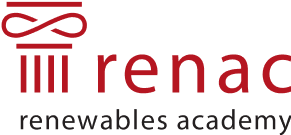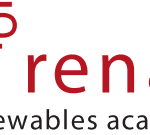This website uses cookies so that we can provide you with the best user experience possible. Cookie information is stored in your browser and performs functions such as recognising you when you return to our website and helping our team to understand which sections of the website you find most interesting and useful.
Customer-specific programmes
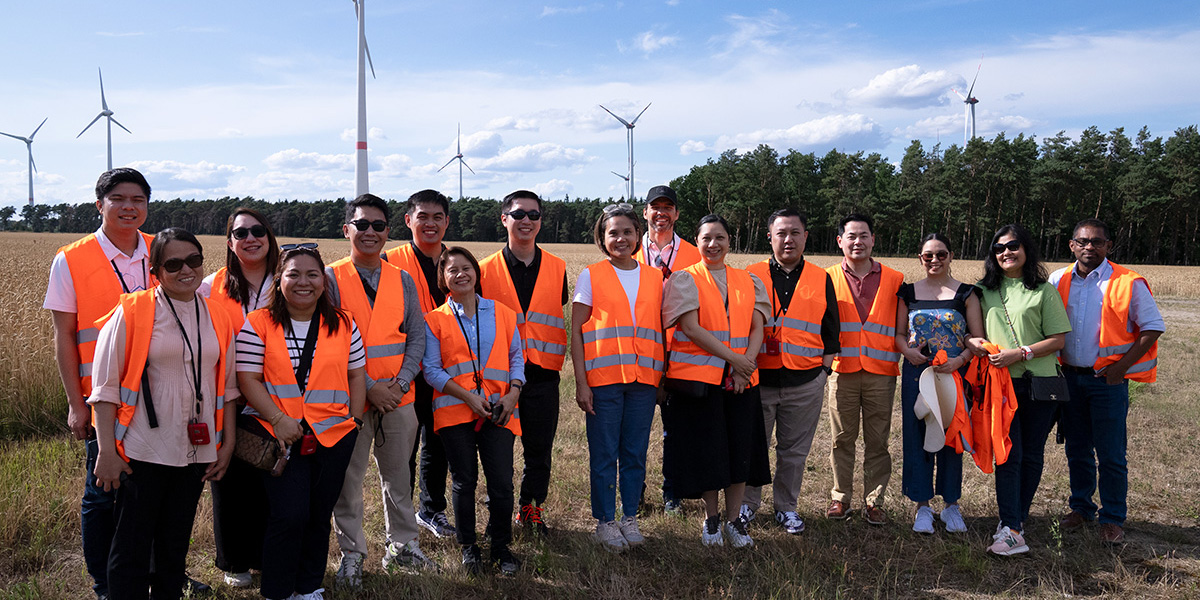
Job requirements in the green energy markets are complex and manifold. To ensure a company or organisation success, employees need extensive skills and up-to-date know-how.
RENAC customer-specific programmes offer the best way to meet participants’ training objectives:
- Analysis of participants’ capacity needs
- Selection of training contents and methods according to prior knowledge and needs
- The most suitable trainers
- Development of comprehensive materials with the highest quality standards
- Implementation of the training
Additionally, the training can be adjusted in duration and depth, organised for groups of various sizes and adapted to cover various technologies. Clients can determine when and where the training takes places.
Filter and search
Type
Name
Duration
Study time
Info
- grid code structure, high/medium/low voltage grids, monitoring, voltage and frequency control
Content:
- Grid code requirement overview
- Voltage control in power systems, steady state
- Voltage control in transmission and distribution networks considering wind power and PV, dynamic behaviour
- Monitoring of system state during actual system operation, re-dispatch and curtailment
- Frequency control for wind power and PV
- Grid code compliance procedures applied at different stages of a VRE project
- Grid study approaches
Learning objectives:
After the seminar participants will be able to:
- name impacts of wind power and photovoltaic (VRE) on system planning and operation,
- explain grid code requirements for photovoltaic and wind power considering voltage control and frequency control strategies
- explain grid code compliance procedures and performance tests for photovoltaic and wind power
- establish frameworks for the sustainable and beneficial integration of increasing volumes of renewable-generated electricity into the grid
- advise on the associated grid-related challenges
Target group:
- Engineers from the public and private sector working in the field of electricity
- Transmission and distribution grid operators
- Energy ministries
- assumptions, modelling, recommendations, structure, typical questions
hours
Content:
• Purpose and typical topics
• Grid integration studies
• System integration studies
• Typical scope of work for grid and system integration studies
Learning objectives:
After completing this course, participants will be able to:
- Explain different types of grid and system integration studies
- Name relevant aspects and relevant time frames of such studies
- Paraphrase study methodologies to explore the impact of wind/PV plants on the grid and on power system operation
Target group:
Professionals from the energy sector (engineers)
- economics, EPC, feasibility studies, operation and maintenance, planning, storage
Content:
- Introduction on current global market trends and PV applications
- Basics on PV technologies
- PV system design with PVSyst (basics)
- Core tasks about grid integration
- PV project development, implementation and O&M
- Different business models
- Economics and bankability of grid-connected PV projects
- Hands-on work with solar equipment
- Site visit to a large-scale PV power plant
Learning objectives:
After the seminar participants will be able to……
• Assess solar resource and yield
• Identify PV plant components
• Design a plant with PVsyst (basic design)
• Analyze operational data from a real PV system
• Evaluate the core activities within the PV value chain
• Assess main steps of project development, implementation and O&M
• Comprehend key stakeholders, project structures, contracts and approvals
• Identify risks, risk mitigation, dos and don’ts
• Assess business models, the KPIs and main costs (CAPEX and OPEX) of PV project calculation
• Evaluate a project with an according economic efficiency calculation tool
Target group:
This training suits those who:
• Are interested in grid-connected PV and have no/little prior knowledge
• Need a comprehensive overview on PV systems and applications
• Start evaluating/developing their first projects such as project developers, project managers, engineers, quality inspectors, and customer service professionals in the photovoltaic industry
- applications, components, economics, operation and maintenance, sizing, system design
hours
Content:
- Fundamentals of Grid-Connected Solar PV Systems
- Components and materials of PV solar systems
- Solar PV system applications
- Design, sizing and economic analysis of solar PV systems
- Operation and maintenance of solar PV systems
Learning objectives:
After completion of this course, participants will be able to:
- Understand the basics of the grid-connected Solar PV technology
- Learn about different energy consumer characteristics
- Recognise the suitability of energy storage depending on the application;
- Discuss application characteristics of PV for the sale and for self-consumption
- Learn about system design, installation, operation and maintenance
- Review international standards
- Analyse financial parameters
Target group:
This training suits professionals who
- Intend to introduce and enhance the financing of green energy systems in their financial institution (e.g. bank managers and staff);
- Intend to promote green energy finance in the financial sector (e.g. policy and decision makers, public organisations)
- Aim at promoting investments in green energy systems among potential investors in the SME sector, specifically solar PV applications (e.g. project developers, representatives from associations, consultancies)
- Are potential investors for green energy systems, specifically solar PV applications for commercial or industrial use (e.g. SMEs, large cooperatives, project developers)
- application in climate zones, coefficient of performance, environmental parameters, refrigerant fluids
hours
Content:
- Definition of a heat pump, its components and its working cycle
- Introduction to the parameters related to environmental and financial performance
- Existing heat pump technologies and their applications
- Heat pumps and their application in their climate zones
- Refrigerant fluids
Learning objectives:
After the seminar, participants will be able to:
- describe a heat pump, including its components and working cycle,
- classify different heat pump working modes,
- evaluate efficiencies, to compare technologies and use cases,
- explain and evaluate economic and environmental parameters,
- describe different heat pump technologies, and their applications in terms of their performance and use in different climate zones and
- classify refrigeration fluids according to their application, global warming potential, and method of disposal.
Target group:
This training suits those who
- need a comprehensive overview of the operating principles for heat pumps used for cooling and heating,
- would like to get an overview on heat pump applications and costs
- want to get information about the environmental impact of heat pumps
- developing feed in time series, grid study scenario development, tools and methods
hours
Content:
• Tools for scenario development
• Scenario development for wind
• Scenario development for PV
• Scenario development for CSP
Learning objectives:
After completing this course, participants will be able to:
- Take steps to generate feed-in time series and dynamic modelling of wind and solar
- Perform scenario simulations (based on numerical weather prediction)
- Calculate the power output of the total wind/PV/CSP capacity in a specific region
Target group:
Professionals from the energy sector (engineers)
- India, South Africa
hours
Content:
Countries available:
- India
- South-Africa
Learning objectives:
After completion of this course, participants will be able to:
- Quantify the impacts of power sector on public health
- Estimate health cost externalities of coal power
- Asses the effects of increased shares of renewable energy in power mix on health impacts and related costs
- Elaborate on the potential a more ambitious decarbonisation scenario has in terms of improving public health and reducing health expenditure
Target group:
- case studies, dynamical modelling, dynamics of generators, importance of inertia, inertia gain, stability and control
hours
Content:
• The Concepts of Power System Stability and Control
• The importance of Inertia in Renewable Power Systems
• Dynamic Power System Modelling (for experts)
• Case Study (for experts)
Learning objectives:
After completing this course, participants will be able to:
- understand the wider context of inertia’s importance to power system stability,
- distinguish the different timescales for frequency control,
- differentiate between conventional and renewable power plants, in terms of their control behaviour,
- identify and determine relevant dynamic stability measures,
- recognise the different standards for frequency stability in different countries,
- define inertia (in the context of conventional power plants),
- illustrate renewable power system challenges, with respect to inertia,
- explain how decreasing inertia changes the frequency gradient,
- define measures to increase power system inertia, with or without storage solutions,
- operate a software framework for modelling the dynamic stability of power grids, in order to investigate the necessary amount of inertia in relevant power systems,
- analyse a case study in the open-source software, powerdynamics.jl, in order to evaluate different solutions to increase inertia and
- identify measures for wind and pv generation, which will ensure that inertia does not become a limiting factor in integrating variable renewable energies.
Target group:
This course suits those who
• are planning distribution and transmission grids with vre,
• want to model how wind and pv change the inertia of an interconnected power supply system,
• are involved in grid operation and grid planning with wind power and photovoltaic,
• need to understand how inertia in the grid is changed by wind and photovoltaic development and
• would like to operate a software to model dynamic stability of a model case power grids with wind power and photovoltaic.
- commissioning, construction, electrical engineering, health and safety, mounting
Content:
• Introduction to photovoltaic systems
• Review of the whole construction and installation process
• Mounting and cabling of PV panels
• String inverter mounting and cabling
• DC and AC wiring (including protective devices), combiner box installation
• Commissioning: testing, measuring and fault-finding
• Installing and wiring monitoring systems
• PV-specific occupational Health and Safety
Learning objectives:
After the seminar participants will be able to…
• Identify special requirements for the installation of main PV system components
• Instruct their workforce to carry out installation tasks in the required quality
• Pinpoint PV specific hazards and propose suitable counter-measures
• Plan and manage construction and maintenance tasks efficiently
Target group:
This training suits those who…
• Responsibly supervise work teams on-site
• Train staff who are to carry out installation tasks
• Manage the construction of PV systems
hours
Content:
- Different power market structure models and associated opportunities and challenges
- Providing flexibility in different market structure models and with an increasing share of variable renewable energies
- Providing ancillary services in a single-buyer market and with an increasing share of variable renewable energies
Learning objectives:
After completion of this course, participants will be able to:
- understand the major differences between the competitive and single-buyer market models, and explain the opportunities and challenges associated with each,
- discuss how flexibility can be provided in different power market structure models and with increasing variable renewable energies (VRE), and
- discuss how ancillary services can be provided in different power market structure models and with increasing VRE.
Target group:
This training suits professionals in regulatory authorities and ministries who
- Are working in / for power supply systems with single buyer markets
- involved in designing strategies for vRE grid integration
- Want to assess whether grid integration measure for vRE are suitable for single buyer markets.
- climate policy framework, leverage points, NDCs, Paris agreement, SDGs
hours
Content:
- International climate policy framework and discourses supporting Renewables
- Overview and Introduction to the NDC Process
- Leverage Points to Mobilise a Renewable Energy Future
- Case studies: national enabling political environments and policies in Germany, South Africa, India
Learning objectives:
After completion of this course, participants will be able to:
- understand the basics of climate science behind the Paris Agreement.
- recall important milestones in the history of the road to the Paris Agreement.
- explain the basic elements and architecture of the Paris Agreement (Goals, NDCs, Transparency Framework, Global Stocktake).
Target group:
This training suits those who:
- are interested in the beneficial side effects of renewable energy in climate change mitigation
- introduction
hours
Content:
• The element hydrogen (H2)Physical and chemical characteristics of ammonia
• Types of hydrogen applicationsEnergy related properties of ammonia
• Hydrogen generation and fuel cellsThe global uses and demand for ammonia
• Developing fields of use for ammoniaHydrogen infrastructure
• System integration / sector couplingAmmonia production technology overview
• The cost of hydrogenNitrogen production technology overview
• International strategies and roadmapsColours of ammonia
Learning objectives:
After completing this online course, participants will be able to:
• Describe the main physical and chemical properties of ammonia,
• Explain its behaviour at different temperatures and pressures,
• Describe the energy content of ammonia.Describe the opportunities and limits of hydrogen as future energy carrier and technology and for a sustainable energy future
• Understand the current status of hydrogen policies in international arena
Target group:
The course is designed for people who would like to get a short overview:
• a brief overview of ammonia, including its properties, uses, and production methods.,
• of the current use of hydrogen, its production technologies, infrastructure and storage as well as
• the importance of sustainable production methods and the potential for ammonia to play a significant role in the transition to a more sustainable and low-carbon energy system.how to include hydrogen in roadmaps and strategies for a sustainable energy supply.
Content:
- Grid code requirement overview
- Voltage control in power systems, steady state
- Voltage control in transmission and distribution networks considering wind power and PV, dynamic behaviour
- Monitoring of system state during actual system operation, re-dispatch and curtailment
- Frequency control for wind power and PV
- Grid code compliance procedures applied at different stages of a VRE project
- Grid study approaches
Learning objectives:
After the seminar participants will be able to:
- name impacts of wind power and photovoltaic (VRE) on system planning and operation,
- explain grid code requirements for photovoltaic and wind power considering voltage control and frequency control strategies
- explain grid code compliance procedures and performance tests for photovoltaic and wind power
- establish frameworks for the sustainable and beneficial integration of increasing volumes of renewable-generated electricity into the grid
- advise on the associated grid-related challenges
Target group:
- Engineers from the public and private sector working in the field of electricity
- Transmission and distribution grid operators
- Energy ministries
Content:
• Purpose and typical topics
• Grid integration studies
• System integration studies
• Typical scope of work for grid and system integration studies
Learning objectives:
After completing this course, participants will be able to:
- Explain different types of grid and system integration studies
- Name relevant aspects and relevant time frames of such studies
- Paraphrase study methodologies to explore the impact of wind/PV plants on the grid and on power system operation
Target group:
Professionals from the energy sector (engineers)
Content:
- Introduction on current global market trends and PV applications
- Basics on PV technologies
- PV system design with PVSyst (basics)
- Core tasks about grid integration
- PV project development, implementation and O&M
- Different business models
- Economics and bankability of grid-connected PV projects
- Hands-on work with solar equipment
- Site visit to a large-scale PV power plant
Learning objectives:
After the seminar participants will be able to……
• Assess solar resource and yield
• Identify PV plant components
• Design a plant with PVsyst (basic design)
• Analyze operational data from a real PV system
• Evaluate the core activities within the PV value chain
• Assess main steps of project development, implementation and O&M
• Comprehend key stakeholders, project structures, contracts and approvals
• Identify risks, risk mitigation, dos and don’ts
• Assess business models, the KPIs and main costs (CAPEX and OPEX) of PV project calculation
• Evaluate a project with an according economic efficiency calculation tool
Target group:
This training suits those who:
• Are interested in grid-connected PV and have no/little prior knowledge
• Need a comprehensive overview on PV systems and applications
• Start evaluating/developing their first projects such as project developers, project managers, engineers, quality inspectors, and customer service professionals in the photovoltaic industry
Content:
- Fundamentals of Grid-Connected Solar PV Systems
- Components and materials of PV solar systems
- Solar PV system applications
- Design, sizing and economic analysis of solar PV systems
- Operation and maintenance of solar PV systems
Learning objectives:
After completion of this course, participants will be able to:
- Understand the basics of the grid-connected Solar PV technology
- Learn about different energy consumer characteristics
- Recognise the suitability of energy storage depending on the application;
- Discuss application characteristics of PV for the sale and for self-consumption
- Learn about system design, installation, operation and maintenance
- Review international standards
- Analyse financial parameters
Target group:
This training suits professionals who
- Intend to introduce and enhance the financing of green energy systems in their financial institution (e.g. bank managers and staff);
- Intend to promote green energy finance in the financial sector (e.g. policy and decision makers, public organisations)
- Aim at promoting investments in green energy systems among potential investors in the SME sector, specifically solar PV applications (e.g. project developers, representatives from associations, consultancies)
- Are potential investors for green energy systems, specifically solar PV applications for commercial or industrial use (e.g. SMEs, large cooperatives, project developers)
Content:
- Definition of a heat pump, its components and its working cycle
- Introduction to the parameters related to environmental and financial performance
- Existing heat pump technologies and their applications
- Heat pumps and their application in their climate zones
- Refrigerant fluids
Learning objectives:
After the seminar, participants will be able to:
- describe a heat pump, including its components and working cycle,
- classify different heat pump working modes,
- evaluate efficiencies, to compare technologies and use cases,
- explain and evaluate economic and environmental parameters,
- describe different heat pump technologies, and their applications in terms of their performance and use in different climate zones and
- classify refrigeration fluids according to their application, global warming potential, and method of disposal.
Target group:
This training suits those who
- need a comprehensive overview of the operating principles for heat pumps used for cooling and heating,
- would like to get an overview on heat pump applications and costs
- want to get information about the environmental impact of heat pumps
Content:
• Tools for scenario development
• Scenario development for wind
• Scenario development for PV
• Scenario development for CSP
Learning objectives:
After completing this course, participants will be able to:
- Take steps to generate feed-in time series and dynamic modelling of wind and solar
- Perform scenario simulations (based on numerical weather prediction)
- Calculate the power output of the total wind/PV/CSP capacity in a specific region
Target group:
Professionals from the energy sector (engineers)
Content:
Countries available:
- India
- South-Africa
Learning objectives:
After completion of this course, participants will be able to:
- Quantify the impacts of power sector on public health
- Estimate health cost externalities of coal power
- Asses the effects of increased shares of renewable energy in power mix on health impacts and related costs
- Elaborate on the potential a more ambitious decarbonisation scenario has in terms of improving public health and reducing health expenditure
Target group:
Content:
• The Concepts of Power System Stability and Control
• The importance of Inertia in Renewable Power Systems
• Dynamic Power System Modelling (for experts)
• Case Study (for experts)
Learning objectives:
After completing this course, participants will be able to:
- understand the wider context of inertia’s importance to power system stability,
- distinguish the different timescales for frequency control,
- differentiate between conventional and renewable power plants, in terms of their control behaviour,
- identify and determine relevant dynamic stability measures,
- recognise the different standards for frequency stability in different countries,
- define inertia (in the context of conventional power plants),
- illustrate renewable power system challenges, with respect to inertia,
- explain how decreasing inertia changes the frequency gradient,
- define measures to increase power system inertia, with or without storage solutions,
- operate a software framework for modelling the dynamic stability of power grids, in order to investigate the necessary amount of inertia in relevant power systems,
- analyse a case study in the open-source software, powerdynamics.jl, in order to evaluate different solutions to increase inertia and
- identify measures for wind and pv generation, which will ensure that inertia does not become a limiting factor in integrating variable renewable energies.
Target group:
This course suits those who
• are planning distribution and transmission grids with vre,
• want to model how wind and pv change the inertia of an interconnected power supply system,
• are involved in grid operation and grid planning with wind power and photovoltaic,
• need to understand how inertia in the grid is changed by wind and photovoltaic development and
• would like to operate a software to model dynamic stability of a model case power grids with wind power and photovoltaic.
Content:
• Introduction to photovoltaic systems
• Review of the whole construction and installation process
• Mounting and cabling of PV panels
• String inverter mounting and cabling
• DC and AC wiring (including protective devices), combiner box installation
• Commissioning: testing, measuring and fault-finding
• Installing and wiring monitoring systems
• PV-specific occupational Health and Safety
Learning objectives:
After the seminar participants will be able to…
• Identify special requirements for the installation of main PV system components
• Instruct their workforce to carry out installation tasks in the required quality
• Pinpoint PV specific hazards and propose suitable counter-measures
• Plan and manage construction and maintenance tasks efficiently
Target group:
This training suits those who…
• Responsibly supervise work teams on-site
• Train staff who are to carry out installation tasks
• Manage the construction of PV systems
Content:
- Different power market structure models and associated opportunities and challenges
- Providing flexibility in different market structure models and with an increasing share of variable renewable energies
- Providing ancillary services in a single-buyer market and with an increasing share of variable renewable energies
Learning objectives:
After completion of this course, participants will be able to:
- understand the major differences between the competitive and single-buyer market models, and explain the opportunities and challenges associated with each,
- discuss how flexibility can be provided in different power market structure models and with increasing variable renewable energies (VRE), and
- discuss how ancillary services can be provided in different power market structure models and with increasing VRE.
Target group:
This training suits professionals in regulatory authorities and ministries who
- Are working in / for power supply systems with single buyer markets
- involved in designing strategies for vRE grid integration
- Want to assess whether grid integration measure for vRE are suitable for single buyer markets.
Content:
- International climate policy framework and discourses supporting Renewables
- Overview and Introduction to the NDC Process
- Leverage Points to Mobilise a Renewable Energy Future
- Case studies: national enabling political environments and policies in Germany, South Africa, India
Learning objectives:
After completion of this course, participants will be able to:
- understand the basics of climate science behind the Paris Agreement.
- recall important milestones in the history of the road to the Paris Agreement.
- explain the basic elements and architecture of the Paris Agreement (Goals, NDCs, Transparency Framework, Global Stocktake).
Target group:
This training suits those who:
- are interested in the beneficial side effects of renewable energy in climate change mitigation
Content:
• The element hydrogen (H2)Physical and chemical characteristics of ammonia
• Types of hydrogen applicationsEnergy related properties of ammonia
• Hydrogen generation and fuel cellsThe global uses and demand for ammonia
• Developing fields of use for ammoniaHydrogen infrastructure
• System integration / sector couplingAmmonia production technology overview
• The cost of hydrogenNitrogen production technology overview
• International strategies and roadmapsColours of ammonia
Learning objectives:
After completing this online course, participants will be able to:
• Describe the main physical and chemical properties of ammonia,
• Explain its behaviour at different temperatures and pressures,
• Describe the energy content of ammonia.Describe the opportunities and limits of hydrogen as future energy carrier and technology and for a sustainable energy future
• Understand the current status of hydrogen policies in international arena
Target group:
The course is designed for people who would like to get a short overview:
• a brief overview of ammonia, including its properties, uses, and production methods.,
• of the current use of hydrogen, its production technologies, infrastructure and storage as well as
• the importance of sustainable production methods and the potential for ammonia to play a significant role in the transition to a more sustainable and low-carbon energy system.how to include hydrogen in roadmaps and strategies for a sustainable energy supply.
Target Groups
Public sector officials for legal frameworks, regulation and implementation:

- Ministries
- Regulators
- Local administrations
Multipliers and development organisations:

- Development corporations
- Energy agencies
- International financing institutions
- NGOs
Private sector:

- Project developers
- System integrators
- Engineers and technicians
- Investors
- Financing institutions
- Grid operators
Capacity building and dissemination sector:

- Public and private training institutions
- Vocational training institutions
- Universities
Value Chain
We design and implement customer-specific programmes and services along the value chain in a holistic concept.
Our approach to Renewable Energy (RE) and Energy Efficiency (EE) is manifold: technology related knowledge is the basis and then each RENAC training and service focus on technical, economic, legal or project related aspects according to the target group. RENAC is also very active in international business matchmaking and market development services.
In our capacity building services we supply a variety of programmes to train trainers, to build training centres and to establish quality assurance processes.
Our Training Concept
Customer-Specific Programmes – what does it mean?
We offer customer-specific programmes according to client needs and participant job requirements in all green energy sectors. Based on an analysis of requested knowledge or specific job tasks and the level of existing knowledge, we develop a training concept proposal.
The concept includes recommendations for online or in-person trainings, or both. We develop the training concept taking the given resources on budget and learning time into account. After feedback from the client, we fine-tune the concept for approval.
Depending on the needs of our clients, we offer different levels of trainings (basic, intermediate, and advanced).
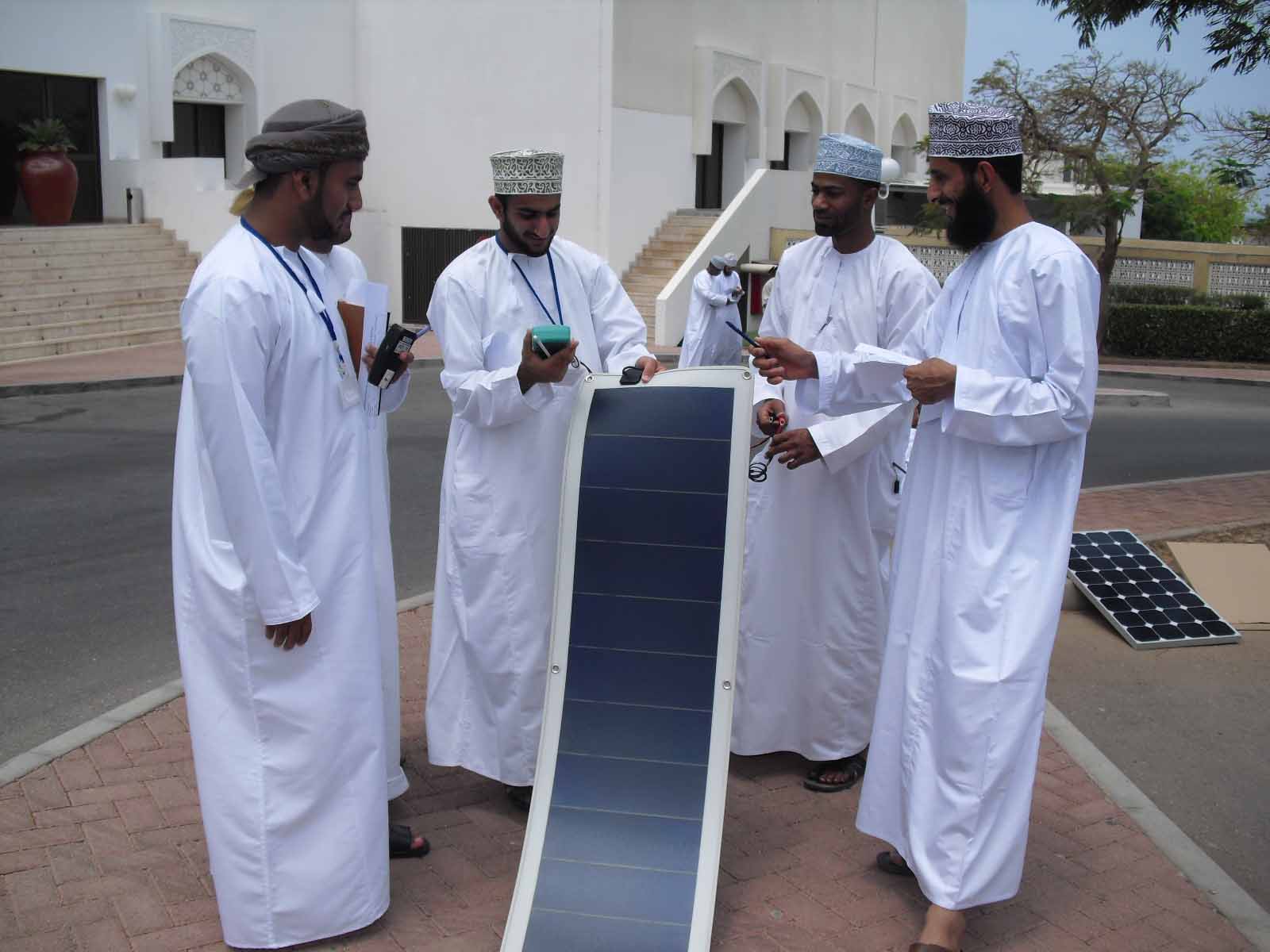
Service Catalogue
Find detailed information about the programme that best aligns with your needs and preferences.
Are you interested in a Customer-specific programmes?
Kindly fill out this questionnaire and attach it to the form on the right:
© 2024 | Renewables Academy (RENAC) AG
